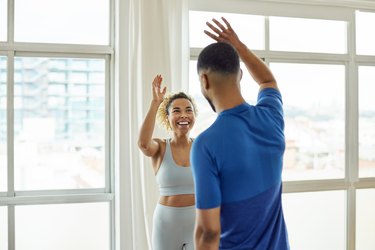
At the end of every January, there tends to be a breadth of news stories about how the majority of New Year's resolutions sputter out after a couple weeks. For example, we hear about how the new-year surge in gym-goers settles back into usual attendance by February. The "resolutions don't work" cycle is so familiar that many people have given up setting fresh goals at all.
The problem? Some research suggests it's not true.
Video of the Day
Video of the Day
For example, a December 2020 study in PLOS One looked at over 1,000 people who set resolutions and what happened a year later. Not surprisingly, the most popular goals centered around physical health, weight loss and eating habits. At the end of the year, 55 percent of participants considered themselves successful in maintaining their resolutions.
When broken down by whether their goals relied on avoidance, such as "I won't eat sugar this year," or relied on a positive strategy like, "I'll cook at home more often to make sure I'm having more vegetables," the latter group was highly successful, with about 59 percent of people sticking to their resolutions.
The takeaway is that resolutions can work, and do for many people. The trick is to establish the right ones — positive, realistic and achievable resolutions can be drivers for change at the start of a new year (or anytime, really!).
What do those resolutions look like? Here, six trainers share the resolutions they've set for themselves as inspiration for your own goal setting.
1. Alleviate Tension to Reduce Stress
Ellen Thompson, CPT, head trainer at Blink Fitness, has a tendency to pack her schedule with both clients and management tasks, and she's found it leads to muscle tightness throughout her body.
"The mind-muscle connection is real," she tells LIVESTRONG.com. "Mental stress goes right into my shoulders, chest, lower back, hips and calves."
For this year, her aim is to create a daily habit of alleviating tension and hopefully preventing it by using a foam roller, trigger point ball, stretch strap and yoga poses. Focusing on dynamic and static stretches to loosen up and ensure she moves through a full range of motion will also help her reduce injury risk when she does her own workouts, she adds.
"Plus, I know this work will give me the type of mood boost I need to mellow any mental stress that comes up," Thompson says.
2. Increase Exercise Frequency
When setting fitness goals, people tend to choose multiple variables — such as lifting a specific amount of weight or running a certain distance at a higher speed — but sometimes, a simple resolution like, "I'll work out more often" is enough, believes Ryan Glatt, CPT, trainer and brain health coach for the Pacific Neuroscience Institute at Providence Saint John's Health Center in California.
"As a professional in health and wellness, I've become unhappy with my body composition and mental health when I exercise less frequency, so that's my sole goal for [the new year]," he tells LIVESTRONG.com. "I believe increasing how often I work out can help me achieve those secondary goals."
Much like the study that emphasized the impact of setting positive goals instead of negative ones, Glatt says realistic resolutions should center on what you gain from sticking to your resolution. So, rather than saying, "I need to work out more because I'm lazy," for example, it's better to say, "I'm going to work out more often to support my emotional health."
3. Expand Your Definition of a Resolution
Although resolutions are often considered as goals, Lindsay Ogden, CPT, a personal trainer at Life Time, says she prefers to take a bigger step back from which actions she'll take and instead answer two questions: "Who do I want to be in the new year?" and "What behaviors or habits align with that version of me?"
"Thinking that way makes me take inventory of what to start, what to stop and what to keep doing," she tells LIVESTRONG.com. "For example, if I want to be a 'morning workout person,' then that leads to a number of actions, like prepping breakfast the night before, stop scrolling on my phone before bed and having an earlier bedtime."
Deciding on those specific actions help her take a big goal like exercising in the morning and break it down into doable, realistic daily habits. When it comes to resolutions, Ogden says deciding on a few steps that lead to who you want to be make success much easier.
4. Choose a Keystone Habit
If you're building an archway, the central stone that holds the entire structure together is called a keystone. That allows the arch to distribute weight equally, and without it, the whole thing would fall apart with even light pressure.
Resolutions can be the same, where one habit is designed to support all the others. For Ben Reale, CPT, a trainer at Condition One Fitness and Nutrition, the keystone is switching to non-alcoholic drinks for the year.
"I'm choosing this because I think it will lead to better sleep, improved recovery from my training, more motivation to read and increased clarity," he tells LIVESTRONG.com. "I'm not seeing this through the lens of what I'm avoiding, but instead, as an approach that lets me get more of what I want."
Setting a keystone like that begins with knowing why you're doing it, he adds, as well as anticipating all the potential obstacles that could dislodge that habit.
5. Get Really Specific
Having big resolutions can be empowering, but smaller and well-clarified resolutions may be better if you want a narrow focus. For instance, Jenna Arndt, head trainer and vice president of fitness programming at Swerve Fitness, completed her first two competitive cycling events and fell just short of the top spot. Her goal for the new year? Being at the top of that podium.
"Now that I better understand the race, I'm coming back looking for a personal best and the gold," she tells LIVESTRONG.com. Because that's such a specific goal, she'll be able to center all of her training around those races. Most notably, she plans on increasing her power output in a way that boosts speed enough to make her a contender.
Similarly, maybe your resolution will be tackling specific event or goal you've considered for years and this is time to make the leap. For example, trainer Chloe Woo, CPT, a trainer at Dogpound, a gym New York City, has set a triathlon as her resolution.
"Prior to the pandemic, it was my goal," she tells LIVESTRONG.com. "I think I'm at the point in my life where I'm ready to do it. For that, I know I need to be more consistent in my running and workouts, no matter how busy I may get. Having this specific goal requires me to be accountable, and that, in turn, is very motivating."
Was this article helpful?
150 Characters Max
0/150
Thank you for sharing!
Thank you for your feedback!


